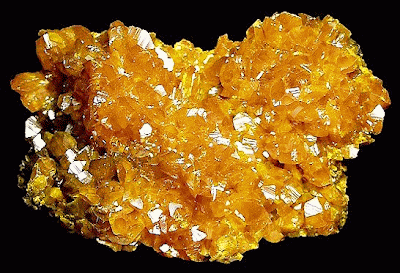Two very pretty, and related, minerals are called orpiment and realgar. Orpiment is a yellow to orange mineral whose name derives from auripigmentum (aurum means "gold" and pigmentum means "pigment" or "color") due to its deep yellow color and use as a paint pigment.
Realgar is a ruby-red mineral whose name comes from the Arabic rahj al-ġār which means "powder of the mine" probably due to its use as a pigment as well.
So what do orpiment and realgar have in common? Turns out they're both arsenic sulfide minerals:
Orpiment = As2S3
Realgar = As4S4
The minerals can also occur together.
Historically orpiment was used as a bright yellow pigment for painting before the development of cadmium yellow. Realgar was used as a ruby-red pigment with one imporant drawback - it fades to a yellow powder after long exposure to light (old paintings where realgar was used now have a yellow color in place of the red the artist intended). Also, one of the major problems with orpiment and realgar pigments is that they're highly toxic, being arsenic compounds.
The fading of realgar pigments also affects the mineral specimens. Realgar needs to be kept in a dark box or drawer, if you leave it out on a bookshelf the mineral will start to break down into a yellow mineral called pararealgar (AsS). I've read that it's the green wavelengths of light that will break down realgar but have no idea why (something I need to research).
Both orpiment and realgar occur in low-temperature hydrothermal veins (fractures in rock in which hot water precipitated minerals), in hot spring deposits, and as sublimates from gasses emitted from volcanic fumaroles. In some areas, these minerals occur with galena (lead sulfide - PbS), gold, and silver deposits. Most of the arsenic produced worldwide comes from these two minerals and another called arsenopyrite (FeAsS).
What use is arsenic? Historically, it was an important poison (it's been called the "Poison of Kings") but today autopsies can detect its presence with some simple chemical tests if it's a suspected cause of death. Victorian women used to ingest arsenic to make them look paler (unlike the tanned commoners who had to work outside). Obviously not a recommended practice. Arsenic was also once used to treat syphilis and other medical conditions. Its poisonous properties have led to its use as a wood preservative (now phased out in the U.S.) and insecticide and fungicide. One high-tech use is in the manufacture of certain semiconductors (notable those made of GaAs - gallium arsenide).
Even though orpiment and realgar are arsenic compounds, they're not really hazardous in a geology lab. Don't chew on the minerals, wash your hands after handling them, and they're fine.
Wednesday, December 15, 2010
Subscribe to:
Post Comments (Atom)






I would presume red light is reflected and/or transmitted, so middle and short wavelengths are preferentially absorbed, and the photons' energy cumulatively breaks down the mineral lattice. But this guess also implies that blue light would have the same effect.
ReplyDeleteNIce info thanks...
ReplyDeleteLots of realgar used in fireworks.
ReplyDeleteHal